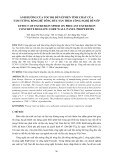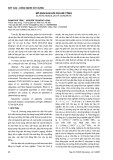
ISSN 1859-1531 - THE UNIVERSITY OF DANANG - JOURNAL OF SCIENCE AND TECHNOLOGY, VOL. 22, NO. 11C, 2024 109
SHORT-TERM PREDICTION OF REGIONAL ENERGY CONSUMPTION BY
METAHEURISTIC OPTIMIZED DEEP LEARNING MODELS
Ngoc-Quang Nguyen*, Phuong-Thao-Nguyen Nguyen, Quynh-Chau Truong
The University of Danang - University of Science and Technology, Viet Nam
*Corresponding author: nnquang@dut.udn.vn
(Received: September 26, 2024; Revised: October 11, 2024; Accepted: October 12, 2024)
DOI: 10.31130/ud-jst.2024.567E
Abstract - Modern civilization is heavily dependent on energy,
which burdens the energy sector. Therefore, a highly accurate
energy consumption forecast is essential to provide valuable
information for efficient energy distribution and storage. This study
proposed a hybrid deep learning model, called I-CNN-JS, by
incorporating a jellyfish search (JS) algorithm into an ImageNet-
winning convolutional neural network (I-CNN) to predict week-
ahead energy consumption. First, numerical data were encoded into
grayscale images for input of the proposed model, showcasing the
novelty of using image data for analysis. Second, a newly
developed metaheuristic optimization algorithm, JS, was used to
improving model accuracy. Results showed that the proposed
method outperformed conventional numerical input methods. The
optimized model yielded a mean absolute percentage error
improvement of 0.5% compared to the default models, indicating
that JS is a promising method for achieving the optimal
hyperparameters. Sensitivity analysis further evaluated the impact
of image pixel orientation on performance model.
Key words - short-term prediction; energy consumption; deep
learning; convolutional neural network; metaheuristic
optimization; machine learning; time-series deep learning
1. Introduction
The energy sector plays a vital role in the global
economy, directly affecting industries, infrastructure, and
social life. Ensuring a stable power supply helps minimize
negative impacts on production and business while
supporting the promotion of industrialization,
modernization, and sustainable development. Forecasting
energy consumption is one of the core factors in the
effective management of the energy system, especially in
the context of increasing scale and volatility in energy
consumption [1].
However, with the increasing integration of renewable
energy sources into the grid, the instability of the energy
supply has become a challenge. The completely
unpredictable nature of sources such as wind and solar,
combined with the ever-changing demand, requires
accurate forecasting tools to support system operators in
decision-making. Therefore, forecasting energy
consumption has become a vital task to optimize energy
distribution, ensuring economic efficiency and
sustainability of the energy system [2].
Traditional methods such as linear regression, time-
based statistical models, or simple machine learning (ML)
techniques have been widely used for many years to forecast
energy consumption [3-5]. However, with the development
of technology and the abundance of data, these methods are
gradually becoming limited when faced with complex and
highly nonlinear energy models [6]. Deep learning (DL) has
emerged as a potential solution due to its ability to learn and
model complex relationships in data. DL can exploit
information from large, multidimensional datasets to
forecast energy consumption more accurately [7].
One of the most widely used DL models is the
convolutional neural network (CNN), thanks to its ability
to capture spatiotemporal relationships as well as time
series features [8]. However, implementing DL models for
energy consumption forecasting also faces significant
challenges, the most important of which is the parameter
optimization process. DL models often require configuring
parameters such as the number of layers, the number of
nodes in each layer, and other hyperparameters, which
directly affect the accuracy and performance of the model.
Optimizing these parameters is often done by trial and error
methods or simple optimization algorithms, but they do not
always guarantee optimal performance for the model.
To improve this optimization, hyperparameter
optimization algorithms have been applied to optimize
hyperparameters and enhance the performance of deep
learning models. These optimization algorithms are
designed to search large parameter spaces, avoiding falling
and local minima, a common problem in traditional
optimization methods, while providing more flexible and
efficient model tuning.
Although DL models have been applied in various
fields, such as image processing, natural language
processing, and medicine, their application in the field of
short-term energy consumption forecasting is still limited
and underexploited. Therefore, this study aims to bridge
this gap by proposing a method that combines I-CNN
models and metaheuristic optimization algorithms for
regional energy consumption forecasting.
Specifically, this study will focus on:
1) Proposing a hybrid DL model based on I-CNN and
JS algorithm to predict energy consumption.
2) Developing an automated process to convert
numerical data into images as input for I-CNN.
3) Conducting sensitivity analysis to examine the effect
of image pixel orientation on model accuracy.
2. Related works
2.1. Convolutional neural network
Convolutional neural networks (CNNs) are a type of
artificial neural network specifically designed to process






























